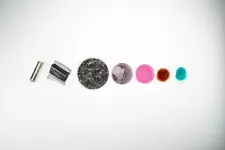Is battery recycling environmentally friendly?
Researchers conduct life-cycle assessment to determine the actual carbon footprint of recycling electric car batteries
2021-03-31
(Press-News.org) Helsinki, Finland -- The EU will be home to 30 million electric cars by 2030 and the European Commission is preparing tough targets for recycling these and other batteries. Yet the impacts of battery recycling, especially for the sizeable lithium-ion batteries of the electric cars soon filling our streets, has been largely unstudied.
In a new study, researchers at Aalto University have investigated the environmental effects of a hydrometallurgical recycling process for electric car batteries. Using simulation-based life-cycle analysis, they considered energy and water consumption, as well as process emissions.
'Battery recycling processes are still developing, so their environmental footprints haven't yet been studied in detail. To be beneficial, recycling must be proven to be more ecological than producing raw materials- we can't just assume recycling is automatically better, even though we know mining the raw materials has large environmental impacts, like high energy and water consumption,' says Mari Lundström, Assistant Professor at Aalto University.
Battery recycling often uses smelting, which typically loses lithium and other raw materials. Novel hydrometallurgical processes, which separate battery metals from waste by dissolution, enable the recovery of all metals but consume large amounts of energy and chemicals, and often produce contaminated wastewaters.
According to the results, the carbon footprint of the raw material obtained by the recycling process studied is 38% smaller than that of the virgin raw material. The difference is even greater if copper and aluminium recovered during mechanical pre-treatment are included. The results also point to problem areas.
'Life-cycle analysis identifies the areas where recycling can be improved. For example, we noticed that using sodium hydroxide as a neutralizing chemical significantly increases the environmental load of our process,' says Marja Rinne, a doctoral student at Aalto University.
This kind of analysis, which the researchers say has been rarely done for battery recycling, can also be done before new processes are taken into use. It is useful for determining how certain choices or process parameters affect the environmental impacts of a process, so it can be a beneficial decision-making tool for both industry and policymakers.
'Simulation-based life-cycle analysis can be used even at the design stage of recycling processes to assess the environmental impacts and find the best possible options,' says Lundström.
The potential benefits of finding the best recycling processes are substantial; the EU aims to recycle 70% of the mass battery waste by the end of the decade. It is also setting targets for specific metals used in batteries: 95% of cobalt, nickel and copper, and 70% of lithium must be recycled by 2030. It is estimated that the global lithium battery recycling market will be worth 19 billion by 2030.
According to Lundström, now is the time to develop alternative recycling methods, as the amount of battery waste will skyrocket with the rapid growth of electric cars.
'We will have a massive need for recycling, and we have to find the most viable and ecological recycling processes. Research into technological innovations and their environmental impact go hand in hand,' she says.
In the study, the team also assessed the industrial scalability of the process and made recommendations on how to best modify the process accordingly.
INFORMATION:
Finland, where Aalto University is located, seeks to be a pioneer in sustainable battery metal production and recycling.
[Attachments] See images for this press release:

ELSE PRESS RELEASES FROM THIS DATE:
2021-03-31
The nucleus is the headquarters of a cell and molecules constantly move across the nuclear membrane through pores. The transport of these molecules is both selective and fast; some 1,000 molecules per second can move in or out. Scientists from the University of Groningen and Delft University of Technology, both in the Netherlands, and a colleague from the Swedish Chalmers University of Technology, have developed an artificial model of these pores using simple design rules, which enabled them to study how this feat is accomplished. Their results were published on 31 March in Nature Communications.
Nuclear pores are extremely complicated structures. The pore itself is a big protein complex and the opening of the pore is filled with a dense network of ...
2021-03-31
First study in bereaved relatives' experience during Covid-19 pandemic lockdown published today
The study makes important recommendations for health and social care professionals providing end-of-life-care
Bereaved families highlighted their need for practical and emotional support when a family member was at end of life
The study found families have increased communication needs when a family member was at end of life, encompassing holistic as well as clinical connections
Phone calls between patients and their relatives should be prioritised during the pandemic to allow loved ones to say goodbye, a new study providing recommendations to healthcare professionals has suggested.
The ...
2021-03-31
Gustavo Aguirre and William Beltran, veterinary ophthalmologists and vision scientists at the University of Pennsylvania School of Veterinary Medicine, have studied a wide range of different retinal blinding disorders. But the one caused by mutations in the NPHP5 gene, leading to a form of Leber congenital amaurosis (LCA), is one of the most severe.
"Children with this disorder are not visual," says Aguirre. "They have a wandering, searching look on their faces and are usually diagnosed at a young age."
A nearly identical disease naturally occurs in dogs. In a new paper in the journal Molecular Therapy, Aguirre, Beltran, and colleagues at Penn and other institutions have demonstrated that a canine gene therapy can restore both normal structure and function to the retina's ...
2021-03-31
University of California, Irvine, biologists have discovered that plants influence how their bacterial and fungal neighbors react to climate change. This finding contributes crucial new information to a hot topic in environmental science: in what manner will climate change alter the diversity of both plants and microbiomes on the landscape? The paper appears in Elementa: Sciences of the Anthropocene.
The research took place at the Loma Ridge Global Change Experiment, a decade-long study in which scientists simulate the impacts of climate change on neighboring grasslands and coastal scrublands in Southern California. Experimental treatments there include nitrogen addition, a common result of local fossil fuel burning, ...
2021-03-31
The human brain regions responsible for speech and communication keep our world running by allowing us to do things like talk with friends, shout for help in an emergency and present information in meetings.
However, scientific understanding of just how these parts of the brain work is limited. Consequently, knowledge of how to improve challenges such as speech impediments or language acquisition is limited as well.
Using an ultra-lightweight, wireless implant, a University of Arizona team is researching songbirds - one of the few species that share humans' ability to learn new vocalizations - to improve scientific ...
2021-03-31
Cone snails aren't glamorous. They don't have svelte waistlines or jaw-dropping good looks. Yet, some of these worm-hunting gastropods are the femme fatales or lady killers of the undersea world, according to a new study conducted by an international team of researchers, including University of Utah Health scientists.
The researchers say the snails use a previously undetected set of small molecules that mimic the effects of worm pheromones to drive marine worms into a sexual frenzy, making it easier to lure them out of their hiding places so the snails can gobble them up.
"In essence, these cone snails have found a way to turn the natural sex drive of their prey into a lethal weapon," says Eric W. ...
2021-03-31
Researchers from Queen Mary University of London have shown for the first time that animal DNA shed within the environment can be collected from the air.
The proof-of-concept study, published in the journal PeerJ, opens up potential for new ecological, health and forensic applications of environmental DNA (eDNA), which to-date has mainly been used to survey aquatic environments.
Living organisms such as plants and animals shed DNA into their surrounding environments as they interact with them. In recent years, eDNA has become an important tool to help scientists identify species found within different environments. However, whilst a range of environmental samples, including ...
2021-03-31
Tomatoes are an important and popular crop, but the tasty ketchup, salsa and pasta sauce they yield comes at a price: overuse of chemical fertilizers. Now, researchers report in ACS' Journal of Agricultural and Food Chemistry they have recruited a fungus to bolster fertilizer efficiency, meaning tastier tomatoes can be grown with less fertilizer.
Tomato plants have a long growth period and need more nutrients -- particularly nitrogen and phosphorus-- than many other crops. Supplying these nutrients through a chemical fertilizer is inefficient, because the nutrients can leach away, evaporate or get trapped in insoluble compounds in the soil, among other problems. Some farmers react by overusing ...
2021-03-31
Key Points
The PURE study is the first multinational study exploring the association between unprocessed and processed meat intakes with health outcomes in low-, middle-, and high-income countries.
The consumption of unprocessed red meat and poultry was not found to be associated with mortality nor major cardiovascular disease events.
In contrast, higher processed meat intake was associated with higher risks of both total mortality and major cardiovascular disease.
Rockville, MD - Red meat is a major source of medium- and long-chain saturated fatty acids, which may lead to an increased risk of cardiovascular disease. Processed meat, which has been modified to improve taste or extend its shelf-life, has also been associated with an increased ...
2021-03-31
Hamilton, ON (March 31, 2021) - A global study led by Hamilton scientists has found a link between eating processed meat and a higher risk of cardiovascular disease. The same study did not find the same link with unprocessed red meat or poultry.
The information comes from the diets and health outcomes of 134,297 people from 21 countries spanning five continents, who were tracked by researchers for data on meat consumption and cardiovascular illnesses.
After following the participants for almost a decade, the researchers found consumption of 150 grams or more of processed meat a week was associated with a 46 per cent higher risk of cardiovascular disease and a 51 per cent ...
LAST 30 PRESS RELEASES:
[Press-News.org] Is battery recycling environmentally friendly?
Researchers conduct life-cycle assessment to determine the actual carbon footprint of recycling electric car batteries



